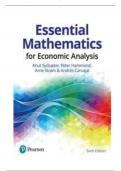lOMoAR cPSD| 27435123
, lOMoAR cPSD| 27435123
Student’s Manual
Essential Mathematics for
Economic Analysis
6th edition
Knut Sydsæter
Peter Hammond
Andrés Carvajal
Arne Strøm
Student’s Manual
, lOMoAR cPSD| 27435123
Contents
1 Essentials of Logic and Set Theory 1
2 Algebra 2
3 Solving Equations 9
4 Functions of One Variable 13
5 Properties of Functions 17
6 Differentiation 19
7 Derivatives in Use 24
8 Concave and Convex Functions 30
9 Optimization 30
10 Integration 34
11 Topics in Finance and Dynamics 42
12 Matrix Algebra 45
13 Determinants, inverses, and Quadratic Forms 49
14 Functions of Many Variables 61
15 Partial Derivatives in Use 63
16 Multiple Integrals 71
17 Unconstrained Optimization 72
18 Equality Constraints 80
19 Linear Programming 89
20 Nonlinear Programming 94
, lOMoAR cPSD| 27435123
1 Essentials of Logic and Set Theory
1.1 Essentials of Set Theory
1.1.9 For this problem we assume that all the relevant sets are subsets of some “universal” set U . Though
the answer given in the text is fairly complete, we use more words in the answer presented here. As in
S book, let {Ai : i ∈ I} denote the family
the answer in the T of sets, indexed by the set I of labels i. Their
union is A∪ = A , and their intersection is A∩ = A.
i∈I i i∈I i
(a) An element x that belongs to the complement of A∪ cannot belong to any of the sets Ai, so it
/ Ai , for all i in I. It followsTthat for every i in I, x is in the complement Aci = U \ Ai of
satisfies x ∈
c
Ai. Thus x belongs to the intersection i∈I Ai of all the sets’ complements.
T
Conversely, if x belongs to the intersection i∈I Aci of all the sets’ complements, then x ∈ / Ai for
/ A , that is, x ∈ (A )c .
all i in I. Then there is no i in I such that x ∈ Ai , which implies that x ∈ ∪ ∪
T
(b) If x belongs to the complement of A∩ = A , then there must be an i in I such that x is not in
c i∈I i
Ai. Then x belongs to the complement A = U \ Ai of Ai. It follows that x must belong to the
S
i
union of all such complements, that is, x ∈ i∈I Aic .
Conversely, if x belongsc the union of all the complements Aic, then for at least one i in I, the
element x belongs to Ai = U \ Ai , that is, x ∈ / Ai . Then x cannot belong to the intersection
∩ T T c
A = i∈I Ai, so x∈( i∈I Ai) .
1.2 Essentials of Logic
1.2.5 (a) If it is false that x ≥ 0 and y ≥ 0, then either x ≥ 0 is false or y ≥ 0 is false (or both), implying that
either x < 0 or y < 0.
Conversely, if either x < 0 or y < 0, then either x ≥ 0 is false or y ≥ 0 is false, so it cannot be true that
both x ≥ 0 and y ≥ 0.
(b) If it is false that all x satisfy x ≥ a, then there exists x such that x < a.
Conversely, if there exists x such that x < a, then it is false that all x satisfy x ≥ a.
(c) If it is false that neither x nor y is less than 5, then it is false that both x ≥ 5 and y ≥ 5, so either
x < 5, or y < 5, or both.
Conversely, if either x < 5, or y < 5, or both, then it is false that both x ≥ 5 and y ≥ 5, so it is false
that neither x nor y is less than 5.
(d) Suppose it is false that for each ε > 0, there exists a δ > 0 such that B is satisfied. Then there
exists an ε > 0 such that there is no δ > 0 such that B is satisfied. So there exists an ε > 0 such that
B is not satisfied for any δ > 0.
Conversely, suppose there exists an ε > 0 such that B is not satisfied for any δ > 0. Then is false that,
for each ε > 0, there exists a δ > 0 such that B is satisfied.
(e) Suppose it is false that no one can help liking cats. Then there exists someone who can resist liking
cats. (Perhaps it is someone with a severe cat allergy.)
Conversely, suppose someone can resist liking cats. Then it is false that no one can help liking cats.
1




